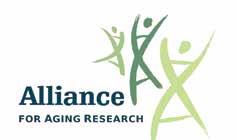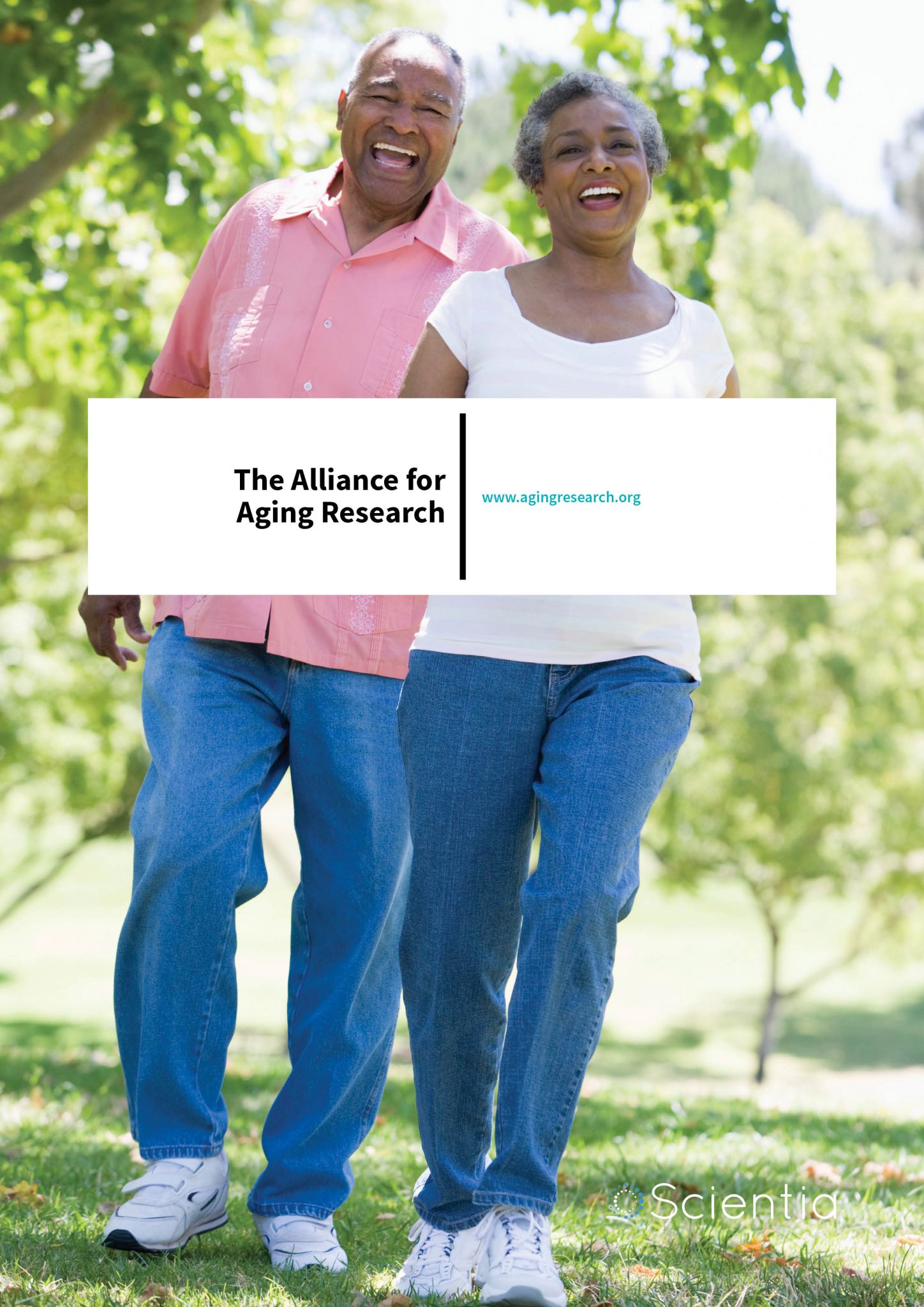THE ALLIANCE FOR AGING RESEARCH
 The Alliance for Aging Research is a national non-profit organisation dedicated to accelerating the pace of scientific discoveries and their application in order to vastly improve the universal human experience of aging and health. Founded 30 years ago in 1986, the Washington D.C. based organisation works to advance innovation that supports the health care needs of older Americans and their caregivers, through targeted federal advocacy and education campaigns. Over the next few pages we speak with Susan Peschin, MHS, the president and CEO at the Alliance for Aging Research, who tells us all about the organisation’s activities in advancing aging research, promoting education, influencing science policy, and more.
The Alliance for Aging Research is a national non-profit organisation dedicated to accelerating the pace of scientific discoveries and their application in order to vastly improve the universal human experience of aging and health. Founded 30 years ago in 1986, the Washington D.C. based organisation works to advance innovation that supports the health care needs of older Americans and their caregivers, through targeted federal advocacy and education campaigns. Over the next few pages we speak with Susan Peschin, MHS, the president and CEO at the Alliance for Aging Research, who tells us all about the organisation’s activities in advancing aging research, promoting education, influencing science policy, and more.
 To start, please describe some of the many ways that the Alliance works to advance science in the field of aging research.
To start, please describe some of the many ways that the Alliance works to advance science in the field of aging research.
Since its founding, the Alliance has advocated for increases in federal funding at the National Institutes of Health (NIH). The Alliance was one of the lead organisations to successfully push for the doubling of the NIH’s budget in 1999, and more recently helped direct the charge for the 200 percent increase in Alzheimer’s research dollars since 2010.
The Alliance has also played a primary role in raising the profile of the rapidly evolving field of geroscience and its promise to extend our heathy years of life, or ‘healthspan’. We launched a nationwide ‘Healthspan Campaign’ in 2012 on Capitol Hill, produced an awardwinning film, The Healthspan Imperative, narrated by Martha Stewart, supported published research on the potential financial value of healthspan extension and created an ever-growing library of interviews with key aging biology researchers.
We have also developed an unparalleled expertise on FDA regulatory issues. The Alliance chairs coalitions focused on Alzheimer’s disease and sarcopenia that bring together patient advocacy organisations, industry, academics, and government agencies to engage with the FDA review divisions on broad issues in clinical development. Our Aging in Motion (AIM) coalition, which focuses on sarcopenia, led the effort to secure an ICD-10-CM code for the condition.
Does the Alliance directly work with funding bodies such as NIA, or the other NIH Institutes? If so, in what way?
Yes, we do. We coordinate frequently with the Director of the National Institute on Aging (NIA), Dr Richard Hodes, and his colleagues on educational events to help raise the profile of the institute’s research. In 2013, we partnered with the Foundation for the NIH (FNIH) to help host the first-ever NIH geroscience summit, and NIA experts are also featured in our Healthspan Imperative film. We have worked with several other NIH institutes and centers on the geroscience effort, ongeriatric cardiac issues, cancer, nutrition and aging, vision loss, and on public-private partnership initiatives in Alzheimer’s disease and related dementias. It is an honour and a pleasure for us to advocate for increased NIH funding overall, and for NIA funding specifically.
 Explain how you work directly with US policymakers to establish legislation that will advance medical breakthroughs. Tell us about a few of your success stories in this regard.
Explain how you work directly with US policymakers to establish legislation that will advance medical breakthroughs. Tell us about a few of your success stories in this regard.
The Alliance has worked on several, high-profile, successful legislative initiatives since its founding. We led a broad coalition opposing Congressional efforts to limit research involving human embryonic stem cells. Thanks in large part to the work of this coalition, these limitations were lifted by Presidential Executive Order in 2009 and replaced with a framework for funding ethical stem cell research with full protections against abuse.
The Alliance was instrumental in advocating for the inclusion of the Patient-Centered Outcomes Research Institute, which funds comparative effectiveness research, into the Affordable Care Act. We have also actively participated in several rounds of the Prescription Drug User Fee Authorization (PDUFA) process, as well as the similar process for medical devices (MDUFA), successfully advocating for provisions that increase the U.S. Food and Drug Administration’s (FDA) focus on patient preferences, institute needed changes in FDA hiring practices, and provide industry support to fund such initiatives.
More recently, we devoted significant efforts to advocating for successful passage of the U.S. House of Representatives’ 21st Century Cures Act, landmark legislation that aims to transform how biomedical research is conducted and how treatments are approved in the U.S. A version of the bill is currently being considered in the Senate.
In addition to promoting aging research and influencing US policy, in what other ways does the Alliance work to enhance the lives of the elderly?
The Alliance serves as a source for reliable information on the health and well-being of older adults. Our Silver Book® program has curated a digital library of informative health education resources on a variety of agerelated diseases and general health topics for policymakers, health care professionals, press, and the public. Our ‘pocket films’ are short in length, animated, and explain complex medical topics and conditions in understandable language. They include topics such as: Alzheimer’s disease, atrial fibrillation, heart valve disease, and sepsis, as well as nutrition and aging and medication safety.
The Alliance also publishes white papers and public opinion surveys, and develops community leader kits so that local organisations can share our information directly with older adults. For more of our education resources, please visit our health information page.
Tell us about one or two promising treatments currently being developed to increase the healthspan of human beings. Describe the role of the Alliance in the development of these treatments?
The Alliance is not directly involved in funding or designing medical research studies, but we regularly collaborate with top experts at the NIH, FDA, and academic centres to raise awareness about the latest advances.
There are a few interventions that have shown promise in animal studies for the increase of healthspan. Researchers fused the circulatory systems of young and old mice to create a shared blood supply, a process called parabiosis. In the old mice, the young blood triggered new muscle and more neural connections, and follow-up studies revealed that their memory formation improved. The researchers discovered that a gene called Creb prompts the rejuvenation. Block the protein produced by Creb, and the young blood loses its anti-aging magic. Another team discovered that a factor called GDF11 increased the number of neural stem cells and stimulated the growth of new blood vessels in the brains of older animals. These intriguing experiments have led to clinical trials that are exploring the impact of plasma from young people on middle aged and elderly Alzheimer’s patients. If the results are positive, this could mark a turning point for the study of diseases of aging.Another potentially promising treatment to slow the aging process that has garnered much attention over the last year is the diabetes drug metformin. Experts at Albert Einstein College of Medicine have initiated the Targeting/Taming Aging with Metformin (TAME) study to test this potential in humans.
‘We remind those in power that there is nothing more consequential they can do than to support the health and well-being of those they serve’

As scientists continue to unravel the biological mechanisms behind aging processes, and develop new ways to increase peoples’ healthspans, do you believe that someday aging may no longer be considered a burden?
Interesting framing. I would say first that burden is a part of life, no matter what age, and that degree of burden is subjective. There is a tremendous amount that we gain from an aging society, but I think that we are not culturally mature enough in the United States to realise that. The perception of burden comes from viewing older adults as non-productive economically, and from increased utilisation of entitlement programs and health care.
There is no question that the science of aging biology has the potential to not only improve overall healthspan, but to reduce health care costs in the long run. An October 2013 Health Affairs piece, which the Alliance partially funded, found that a successful intervention in delayed aging could increase life expectancy by an additional 2.2 years, most of which would be spent in good health and with an economic value estimated to be $7.1 trillion over fifty years. The authors point out that, should this come to pass, reasonable adjustments would need to be made to entitlement programs.
However, in order for us to realise the potential of geroscience, there needs to be significant public and private investment in this area of research, such as there has been for disease-specific research. To this end, the Alliance is pursuing a cross-government geroscience coordinating committee to improve funding prospects and partnerships across research agencies—much like what has been done for diabetes, autism, and breast cancer.
In the meantime, we will continue to push institutions, researchers, health care providers, and decision-makers to put themselves in the shoes of senior patients and their family caregivers. We do this in order to bridge the gap between what health care providers say and what patients actually hear; to improve development of, and access to, much-needed treatments for age-related diseases; and to remind those in power that there is nothing more consequential they can do than to support the health and well-being of those they serve.

